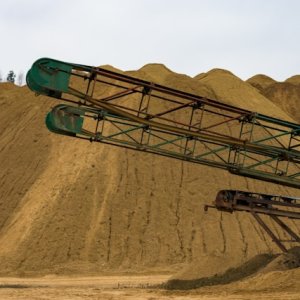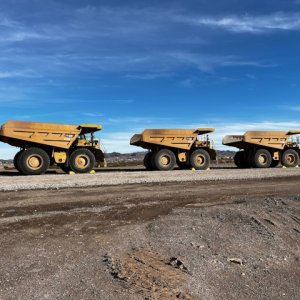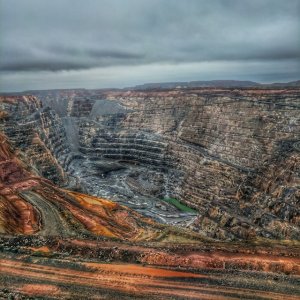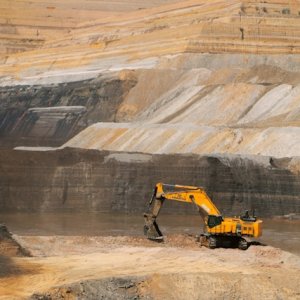Overview of Drilling Techniques
STORY INLINE POST
ROTATORY AIR BLAST DRILLING
Rotatory Air Blast drilling (RAB) is the most common drilling method used in the exploration industry. The tool itself, also known as a down-the-hole drill, uses a pneumatic reciprocating piston-driven hammer to energetically drive a heavy drill bit into the rock. The machine recovers cuttings to the surface through pumping compressed air down the center of the drill system. The drill bit is hollow, made of solid steel and has 20mm thick tungsten rods protruding from the steel matrix as buttons, which are the cutting face of the bit. RAB drilling is used primarily for mineral exploration, water bore drilling, and blast-hole drilling in mines. Large diameter core drilling is recommended for bulk sampling and where core samples are required. If it encounters water, RAB drilling at extreme depth may rapidly clog the outside of the hole with debris precluding removal of drill cuttings from the hole. However, this can be counteracted with the use of stabilizers, also known as reamers, which are large cylindrical pieces of steel attached to the drill string and made to perfectly fit the size of the hole being drilled. These have sets of rollers on the side that constantly break down cuttings being pushed upwards.
REVERSE CIRCULATION DRILLING
Reverse Circulation drilling (RC) is similar to air core drilling in that the drill cuttings are returned to surface inside the rods. This type of drilling utilizes much larger rigs and machinery and depths of up to 500m are routinely achieved. RC drilling ideally produces dry rock chips, as large air compressors dry the rock out ahead of the advancing drill bit. It is slower and costlier but achieves better penetration than RAB or Air Core drilling. On the other hand, it is cheaper than diamond coring and therefore is preferred for most mineral exploration work. Reverse circulation is achieved by blowing air down the rods. The differential pressure creates air lift of the water and cuttings up the inner tube, which is inside each rod. It reaches the divertor at the top of the hole, and then moves through a sample hose which is attached to the top of the cyclone. The drill cuttings travel around the inside of the cyclone until they fall through an opening at the bottom and are collected in a sample bag. Although RC drilling is air-powered, water is also used to reduce dust, keep the drill bit cool, and assist in pushing cutting back upwards, as well as when collaring a new hole.
DIAMOND CORE DRILLING
Diamond Core drilling uses an annular diamond- impregnated drill bit attached to the end of hollow drill rods to cut a cylindrical core of solid rock. The diamonds used to make diamond core bits are a variety of sizes, fine to microfine industrial grade diamonds, and the ratio of diamonds to metal used in the matrix affects the performance of the bits cutting ability in different types of rock formations. The diamonds are set within a matrix of varying hardness, from brass to high-grade steel. Matrix hardness, diamond size, and dosing can vary according to the rock that must be cut. The bits made with hard steel with a low diamond count are ideal for softer highly fractured rock, while others made of softer steels and high diamond ratio are good for coring in hard solid rock. Holes within the bit allow water to be delivered to the cutting face. This provides three essential functions: lubrication, cooling, and removal of drill cuttings from the hole. Diamond drilling is much slower than RC drilling due to the hardness of the ground being drilled. Drilling 1,200 to 1,800m is common, and at these depths the ground is mainly hard rock.
PERCUSSION DRILLING
Direct push technology includes several types of drilling rigs and drilling equipment that advance a drill string by pushing or hammering without rotating the drill string. While this does not meet the proper definition of drilling, it does achieve the same result: a borehole. Direct Push rigs include both Cone Penetration Testing (CPT) rigs and direct push sampling rigs. These types of rigs are typically limited to drilling in unconsolidated soil materials and very soft rock. CPT rigs advance specialized testing equipment and soil samplers using large hydraulic rams. Most CPT rigs are heavily ballasted (20 tonnes is typical) as a counter force against the pushing force of the hydraulic rams, which go up to 20kN. Alternatively small and light CPT rigs and offshore CPT rigs will use anchors such as screwed-in ground anchors to create the reactive force. In ideal conditions, CPT rigs can achieve production rates of up to 250–300m per day. A cylindrical steel cone is pushed hydraulically into the soil to identify soil types and groundwater migration pathways. Through the use of electronic strain gauges that measure physical soil properties, the acquired data produces a continuous, real time stratigraphic record or sounding.





















